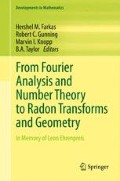Abstract
The late Leon Ehrenpreis originally posed the problem of showing that the difference of the two Rogers–Ramanujan products had positive coefficients without invoking the Rogers–Ramanujan identities. We first solve the problem generalized to the partial products and subsequently solve several related problems. The object is to introduce the anti-telescoping method which is capable of wide generalization.
Access this chapter
Tax calculation will be finalised at checkout
Purchases are for personal use only
References
G. E. Andrews, An analytic proof of the Rogers-Ramanujan-Gordon identities, Amer. J. Math., 88 (1966), 844–846.
G. E. Andrews A generalization of the Göllnitz-Gordon partition theorems, Proc. Amer. Math. Soc., 18 (1967), 945–952.
G. E. Andrews, Applications of basic hypergeometric functinos, SIAM Review, 16 (1974), 441–484.
G. E. Andrews and R. J. Baxter, A motivated proof of the Rogers-Ramanujan identities, Amer. Math. Monthly, 96 (1989), 401–409.
G. E. Andrews and K. Eriksson, Integer Partitions, Cambridge University Press, Cambridge, 2004.
A. Berkovich and F. Garvan, Dissecting the Stanley partition function, J. Comb. Th. (A), 112 (2005), 277–291.
H. Göllnitz, Partitionen mit Differenzenbedingungen, J. reine u. angew. Math., 225 (1965), 154–190.
B. Gordon, A combinatorial generalization of the Rogers-Ramanujan identities, Amer. J. Math., 83 (1961), 393–399.
K. W. J. Kadell, An injection for the Ehrenpreis Rogers-Ramanujan problem, J. Comb. Th. (A), 86 (1999), 390–394.
Acknowledgements
Partially supported by National Science Foundation Grant DMS-0801184
Author information
Authors and Affiliations
Corresponding author
Editor information
Editors and Affiliations
Additional information
Dedicated to the memory of the great Leon Ehrenpreis.
Rights and permissions
Copyright information
© 2013 Springer Science+Business Media New York
About this chapter
Cite this chapter
Andrews, G.E. (2013). Differences of Partition Functions: The Anti-telescoping Method. In: Farkas, H., Gunning, R., Knopp, M., Taylor, B. (eds) From Fourier Analysis and Number Theory to Radon Transforms and Geometry. Developments in Mathematics, vol 28. Springer, New York, NY. https://doi.org/10.1007/978-1-4614-4075-8_1
Download citation
DOI: https://doi.org/10.1007/978-1-4614-4075-8_1
Published:
Publisher Name: Springer, New York, NY
Print ISBN: 978-1-4614-4074-1
Online ISBN: 978-1-4614-4075-8
eBook Packages: Mathematics and StatisticsMathematics and Statistics (R0)

